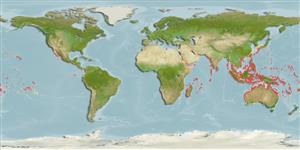Common names from other countries
Classification / Names / Names
Namen | Synonyme | Catalog of Fishes (gen., sp.) | ITIS | CoL | WoRMS
Environment: milieu / climate zone / depth range / distribution range
Ökologie
; tiefenbereich 0 - 20 m (Ref. 348). Tropical
Indo-West Pacific: from eastern and southern Africa, to western Polynesia; north to Japan and Hawaii, and south to New Caledonia; Society Islands, eastern Polynesia.
Length at first maturity / Size / Gewicht / Alter
Maturity: Lm ? range ? - ? cm Max length : 7.5 cm ShL Männchen/unbestimmt; (Ref. 348); common length : 4.0 cm SL Männchen/unbestimmt; (Ref. 348)
Byssally attached to rocks, on reef flats or to the underside of boulders, on sand and gravel bottoms. May also occur at sub-littoral (Ref. 348) and intertidal depths on soft sediments (Ref. 87907).
Life cycle and mating behavior
Geschlechtsreife | Fortpflanzung | Ablaichen | Eier | Fecundity | Larven
Members of the class Bivalvia are mostly gonochoric, some are protandric hermaphrodites. Life cycle: Embryos develop into free-swimming trocophore larvae, succeeded by the bivalve veliger, resembling a miniature clam.
Poutiers, J.M. 1998. (Ref. 348)
IUCN Rote Liste Status (Ref. 130435)
CITES Status (Ref. 108899)
Not Evaluated
Not Evaluated
Bedrohung für Menschen
Harmless
Nutzung durch Menschen
| FishSource |
Tools
Mehr Information
Alter/GrößeWachstumLänge-GewichtLänge-LängeMorphologieLarvenDichte
Internet Quellen
Estimates based on models
Preferred temperature
(Ref.
115969): 24.6 - 29.3, mean 28.4 (based on 3503 cells).
Verwundbarkeit
Low vulnerability (10 of 100).
Preiskategorie
Unknown.
